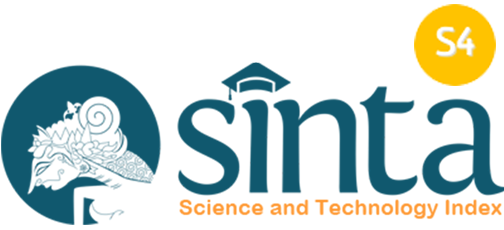The Acceleration of Ev User in Medan: Through The Implementation of Marketing Mix and Ev Policy
Abstract
Electric Vehicles (EV) are an important pathway for decarbonizing transportation and a form of renewable energy as an environmentally friendly technology to accelerate sustainable development. This is in line with the Indonesian government's target in the Nationally Determined Contribution (NDC) document of reducing emissions by 31.89% in 2030. This paper aims to find out the government policies in accelerating the use of EV in Indonesia, especially in the city of Medan. Semi-structured interviews were done supported by voice note recordings, data collection, and observations of informants who were directly involved in the social conditions studied, that were those from four EV dealers in Medan City and additional informants, who were consumers who already use EV and the community, who have not used an electric vehicle, but know about the existence of the electric vehicle. The result the current policy has resulted in an increase in sales of 50% -60% and the use of EV in the city of Medan by 30%. Policies such as exemption from toll fees, parking in public places, and parking spaces that are easily accessible for electric vehicle drivers are needed. Apart from that, certainty is also needed regarding the policy on entry fees and EV impor taxes, which will affect EV production, especially pricing and variation. In conclusion, the policy cannot stand alone but is supported by a 4P marketing mix strategy (price, product, place, and promotion).
Keywords: Electric Vehicle (EV), Marketing Strategy, Policy Incentive, Policy Option
Full Text:
PDFReferences
N. Naurah, “Sederet Subsektor Transportasi yang Jadi Kontributor Emisi Karbon Terbesar, Mobil Terbanyak!,” GoodStat, 2023. https://goodstats.id/article/sederet-subsektor-transportasi-yang-jadi-kontributor-emisi-karbon-terbesar-mobil-terbanyak-rbMLy#:~:text=Berdasarkan data dari Badan Energi,mencapai 48%25 pada tahun 2022. (accessed Oct. 27, 2023).
P. Goel, N. Sharma, K. Mathiyazhagan, and K. E. K. Vimal, “Government is trying but consumers are not buying: A barrier analysis for electric vehicle sales in India,” Sustain. Prod. Consum., vol. 28, pp. 71–90, 2021, doi: 10.1016/j.spc.2021.03.029.
J. D. Quartey, “Sustainable Energy Delivery for Africa’S Changing Climate: an Economic Assessment,” Asian Dev. Policy Rev., vol. 8, no. 3, pp. 214–235, 2020, doi: 10.18488/journal.107.2020.83.214.235.
A. Sajjad, J. Chu, M. A. Anwar, and F. Asmi, “Between green and gray: Smog risk and rationale behind vehicle switching,” J. Clean. Prod., vol. 244, p. 118674, 2020, doi: 10.1016/j.jclepro.2019.118674.
P. Plötz, U. Schneider, J. Globisch, and E. Dütschke, “Who will buy electric vehicles? Identifying early adopters in Germany,” Transp. Res. Part A Policy Pract., vol. 67, pp. 96–109, 2014, doi: 10.1016/j.tra.2014.06.006.
J. H. M. Langbroek, J. P. Franklin, and Y. O. Susilo, “The effect of policy incentives on electric vehicle adoption,” Energy Policy, vol. 94, pp. 94–103, 2016, doi: 10.1016/j.enpol.2016.03.050.
T. Gnann, P. Plötz, A. Kühn, and M. Wietschel, “Modelling market diffusion of electric vehicles with real world driving data - German market and policy options,” Transp. Res. Part A Policy Pract., vol. 77, no. 2015, pp. 95–112, 2015, doi: 10.1016/j.tra.2015.04.001.
J. Li, J. Jiao, and Y. Tang, “An evolutionary analysis on the effect of government policies on electric vehicle diffusion in complex network,” Energy Policy, vol. 129, no. September 2018, pp. 1–12, 2019, doi: 10.1016/j.enpol.2019.01.070.
C. M. Annur, “Meski BBM Naik, Kebanyakan Warga RI Tak Berminat Beralih ke Kendaraan Listrik,” Katadata.co.id, 2022. https://databoks.katadata.co.id/datapublish/2022/09/23/meski-bbm-naik-kebanyakan-warga-ri-tak-berminat-beralih-ke-kendaraan-listrik (accessed Jan. 24, 2023).
IEA, “Global EV Outlook 2021 - Accelerating ambitions despite the pandemic,” 2021. [Online]. Available: https://iea.blob.core.windows.net/assets/ed5f4484-f556-4110-8c5c-4ede8bcba637/GlobalEVOutlook2021.pdf.
R. Subekti, “Dan Penggunaan Energi Terbarukan,” J. RECHTS VINDING, vol. 11, pp. 435–450, 2022.
A. Y. Hartanto, “Jutaan Kendaraan Listrik Diprediksi Mengaspal dalam Waktu Dekat,” tirto.id, 2023. https://tirto.id/jutaan-kendaraan-listrik-diprediksi-mengaspal-dalam-waktu-dekat-gCPw (accessed May 05, 2023).
D. Siswanto, “Sri Mulyani Siapkan Aturan Impor Mobil Listrik Utuh Bebas Pajak,” 2023. https://nasional.kontan.co.id/news/sri-mulyani-siapkan-aturan-impor-mobil-listrik-utuh-bebas-pajak (accessed Sep. 02, 2023).
D. Aulia, “Penjualan Kendaraan Listrik Sumut di Tokopedia Meningkat Hampir Dua Kali Lipat Artikel ini telah tayang di Tribun-Medan.com dengan judul Penjualan Kendaraan Listrik Sumut di Tokopedia Meningkat Hampir Dua Kali Lipat, https://medan.tribunnews.com/2023/06/1,” Tribun Medan, 2023. https://medan.tribunnews.com/2023/06/15/penjualan-kendaraan-listrik-sumut-di-tokopedia-meningkat-hampir-dua-kali-lipat (accessed Aug. 15, 2023).
K. H. Kabir and S. Aftab, “Exploring Management Strategies for Freshwater Wetland: Policy Options for Southwest Coastal Region in Bangladesh,” Asian Dev. Policy Rev., vol. 5, no. 2, pp. 70–80, 2017, doi: 10.18488/journal.107.2017.52.70.80.
L. Han, S. Wang, D. Zhao, and J. Li, “The intention to adopt electric vehicles: Driven by functional and non-functional values,” Transp. Res. Part A Policy Pract., vol. 103, pp. 185–197, 2017, doi: 10.1016/j.tra.2017.05.033.
H. L. Breetz and D. Salon, “Do electric vehicles need subsidies? Ownership costs for conventional, hybrid, and electric vehicles in 14 U.S. cities,” Energy Policy, vol. 120, no. May, pp. 238–249, 2018, doi: 10.1016/j.enpol.2018.05.038.
M. Chowdhury, K. Salam, and R. Tay, “Consumer preferences and policy implications for the green car market,” Mark. Intell. Plan., vol. 34, no. 6, pp. 810–827, 2016, doi: 10.1108/MIP-08-2015-0167.
B. Yıldırım, “Preschool Education in Turkey During the Covid-19 Pandemic: A Phenomenological Study,” Early Child. Educ. J., vol. 49, no. 5, pp. 947–963, 2021, doi: 10.1007/s10643-021-01153-w.
M. B. Miles, A. M. Huberman, T. R. Rohidi, and Mulyarto, Anallisis Data Kualitatif: Buku Sumber tentang Metode-Metode Baru. Jakarta: Penerbit Universitas Indonesia (UI-Press), 1992.
F. Rangkuti, Flexible Marketing. Jakarta: PT Gramedia Pustaka Utama, 2004.
Cannon, Perreault, and McCarthy, Basic Marketing A Global-Managerial Approach. New York: MCGraw-Hill, 2008.
A. M. A. Suyanto and W. S. Pasaribu, “ANALYSIS OF INDONESIAN SOCIETY ’ S PREFERENCES FOR THE PRESENCE OF ELECTRIC VEHICLES Achmad Manshur Ali Suyanto A , Widi Sriwahyuni Pasaribu B Article history : Keywords : Conjoint Analysis ; Customer Preference ; Analysis of Indonesian Society ’ s Prefer,” Int. J. Prof. Bus. Rev., vol. 8, pp. 1–18, 2023.
G. Cecere, N. Corrocher, and M. Guerzoni, “Price or performance? A probabilistic choice analysis of the intention to buy electric vehicles in European countries,” Energy Policy, vol. 118, no. March, pp. 19–32, 2018, doi: 10.1016/j.enpol.2018.03.034.
K. Y. Bjerkan, T. E. Nørbech, and M. E. Nordtømme, “Incentives for promoting Battery Electric Vehicle (BEV) adoption in Norway,” Transp. Res. Part D Transp. Environ., vol. 43, pp. 169–180, 2016, doi: 10.1016/j.trd.2015.12.002.
S. Mehar, G. Rémy, S. Zeadally, and S. M. Senouci, “Smart Management System for a Fleet of Electric Vehicles,” IEEE Trans. Intell. Transp. Syst., vol. 16, no. 3, pp. 1401–1414, 2015.
Y. Zhang, The 4P ’ s of Marketing Mix Analysis : The Uniqueness of Tesla ’ s Strategic Marketing Tactics in China, no. Esfct 2023. Atlantis Press International BV, 2023.
D. Andi, “Kendaraan Konvensional Akan Dibatasi, Produsen Otomotif Tunggu Kejelasan Aturan,” Kontan.co, 2023. https://industri.kontan.co.id/news/kendaraan-konvensional-akan-dibatasi-produsen-otomotif-tunggu-kejelasan-aturan (accessed Jul. 02, 2023).
A. Laraspati, “Penjualan Kendaraan Listrik di Tokopedia Naik, Daerah ini Terbanyak,” Detik,Oto, 2023. https://oto.detik.com/kendaraan-listrik/d-6760681/penjualan-kendaraan-listrik-di-tokopedia-naik-daerah-ini-terbanyak (accessed Aug. 01, 2023).
MistarHarian, “Mobil Listrik Mulai Ramai di Jalanan, Sehari Ada 10 Unit yang Cas di SPKLU Medan,” Mistar Harian, 2023. https://mistar.id/medan/mobil-listrik-mulai-ramai-di-jalanan-sehari-ada-10-mobil-yang-cas-di-spklu-medan/ (accessed Jul. 08, 2023).
A. P. Niagara, “Ini Daftar 5 Mobil Listrik yang Lebih Murah dari Toyota Avanza,” KumparanOTO, 2021. https://kumparan.com/kumparanoto/ini-daftar-5-mobil-listrik-yang-lebih-murah-dari-toyota-avanza-1vMuBw7txLI/full (accessed Jun. 08, 2023).
K. P. Jati, “Moeldoko: Masyarakat Masih Ragu Pakai Kendaraan Listrik Karena Kurang Edukasi,” Rm.id, 2022. https://rm.id/baca-berita/nasional/133508/moeldoko-masyarakat-masih-ragu-pakai-kendaraan-listrik-karena-kurang-edukasi (accessed Jul. 08, 2023).
A. Waheed, J. Yang, Z. Ahmed, K. Rafique, and M. Ashfaq, “Is Marketing Limited to Promotional Activities? The Concept of Marketing: A Concise Review of the Literatur,” Asian Dev. Policy Rev., vol. 5, no. 1, pp. 56–69, 2017, doi: 10.18488/journal.107.2017.51.56.69.
L. Aprilia, Y. P. Desi, and S. Purnomo, “Jurnal Ilmiah Manajemen Informasi dan Komunikasi PENGARUH KONTEN REVIEW DAN ELECTRONIC WORD OF MOUTH TERHADAP MINAT BELI MOBIL LISTRIK ( Studi Kuantitatif Pada Channel Youtube Fitra Eri , Ridwan Hanif , Dan Oto Driver ) THE EFFECT OF REVIEW CONTENT AND EL,” vol. 7, no. 1, 2023.
A. Ullah, W. Aimin, and M. Ahmed, “Smart automation, customer experience and customer engagement in electric vehicles,” Sustain., vol. 10, no. 5, 2018, doi: 10.3390/su10051350.
CNNIndonesia, “Transaksi Pameran Kendaraan Listrik PEVS 2023 Diklaim Tembus Rp289 M,” CNN Indonesia, 2023. https://www.cnnindonesia.com/otomotif/20230522063935-603-952214/transaksi-pameran-kendaraan-listrik-pevs-2023-diklaim-tembus-rp289-m (accessed Aug. 08, 2023).
V. T. P. Sidabutar, “Kajian pengembangan kendaraan listrik di Indonesia: prospek dan hambatannya,” J. Paradig. Ekon., vol. 15, no. 1, p. 14, 2020, [Online]. Available: https://www.lemhannas.go.id/index.php/berita/berita-utama/844-pancasila-di-tengah-era-globalisasi.
A. Ahdiat, “Volume Penjualan Wholesale Bulanan Mobil LIstrik BEV di Indonesia,” Databoks, 2023. https://databoks.katadata.co.id/datapublish/2023/09/19/penjualan-mobil-listrik-di-indonesia-meningkat-pada-agustus-2023 (accessed Sep. 25, 2023).
H. P. Sari and E. Djumena, “Insentif Kendaraan Listrik Mulai 20 Maret 2023, Simak Skema, Penerimaan, dan Produsennya,” Kompas.com, 2023. https://money.kompas.com/read/2023/03/07/083400626/insentif-kendaraan-listrik-mulai-20-maret-2023-simak-skema-penerima-dan?page=all (accessed Jul. 28, 2023).
H. Zakharia, “Sederet Insentif Pengembangan SPKLU, Apa Saja?,” Liputan6.com, 2021. https://www.liputan6.com/bisnis/read/4649424/sederet-insentif-pengembangan-spklu-apa-saja?page=2 (accessed Jul. 10, 2023).
M. A. Aasness and J. Odeck, “The increase of electric vehicle usage in Norway—incentives and adverse effects,” Eur. Transp. Res. Rev., vol. 7, no. 4, 2015, doi: 10.1007/s12544-015-0182-4.
W. Li et al., “Public preference for electric vehicle incentive policies in China: A conjoint analysis,” Int. J. Environ. Res. Public Health, vol. 17, no. 1, pp. 1–16, 2020, doi: 10.3390/ijerph17010318.
M. Ščasný, I. Zvěřinová, and M. Czajkowski, “Electric, plug-in hybrid, hybrid, or conventional? Polish consumers’ preferences for electric vehicles,” Energy Effic., vol. 11, no. 8, pp. 2181–2201, 2018, doi: 10.1007/s12053-018-9754-1.
CNNIndonesia, “PLN Diskon Biaya cas Mobil Listrik Malam Hari 30 Persen,” CNN Indonesia, 2021. https://www.cnnindonesia.com/otomotif/20210922194409-603-698107/pln-diskon-biaya-cas-mobil-listrik-malam-hari-30-persen (accessed Aug. 12, 2023).
F. Egnér and L. Trosvik, “Electric vehicle adoption in Sweden and the impact of local policy instruments,” Energy Policy, vol. 121, no. May, pp. 584–596, 2018, doi: 10.1016/j.enpol.2018.06.040.
Refbacks
- There are currently no refbacks.







